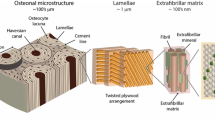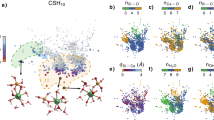Abstract
Molecular dynamics (MD) simulations have been used to study calcium phosphate formation regulated by collagen in solution. In this study, a collagen-like peptide molecule has been mixed with different types of ions for simulations of the early stage of biomineralization. We have compared one system containing calcium ions, and hydrogen phosphate ions to the other system containing calcium ions, phosphate ions and hydroxy ions in a water box containing a peptide molecule (1CAG) in the center. After the simulations, the radical distance function and coordination number profiles show that calcium ions and phosphate ions attract each other and form stable clusters in both systems studied. The hydroxy ions are attracted by calcium ions and the distance between them is close to that in hydroxyapatite, which is considered to play important roles in the formation of hydroxyapatite. The current results provide a useful approach to study the scenario of mineralizing collagen using MD methods.







Similar content being viewed by others
References
Lutolf MP, Hubbell JA (2005) Synthetic biomaterials as instructive extracellular microenvironments for morphogenesis in tissue engineering. Nat Biotechnol 23:47–55
Place ES, Evans ND, Stevens MM (2009) Complexity in biomaterials for tissue engineering. Nat Mater 8:457–470
George A, Ravindran S (2010) Protein templates in hard tissue engineering. Nano Today 5:254–266
Woodruff MA, Lange C, Reichert J et al (2012) Bone tissue engineering: from bench to bedside. Mater Today 15:430–435
Cui FZ, Li Y, Ge J (2007) Self-assembly of mineralized collagen composites. Mater Sci Eng R 57:1–27
Hoyer B, Bernhardt A, Heinemann S et al (2012) Biomimetically mineralized salmon collagen scaffolds for application in bone tissue engineering. Biomacromolecules 13:1059–1066
Colfen H (2010) Biomineralization: a crystal-clear view. Nat Mater 9:960–961
Slepko A, Demkov AA (2011) First-principles study of the biomineral hydroxyapatite. Phys Rev B 84:134108
Tamm T, Peld M (2006) Computational study of cation substitutions in apatites. J Solid State Chem 179:1581–1587
Hu W, Ma J, Wang JL et al (2012) Fine structure study on low concentration zinc substituted hydroxyapatite nanoparticles. Mat Sci Eng C 32:2404–2410
Bhowmik R, Katti KS, Katti D (2007) Molecular dynamics simulation of hydroxyapatite–polyacrylic acid interfaces. Polymer 48:664–674
Zhang HP, Lu X, Leng Y et al (2009) Molecular dynamics simulations on the interaction between polymers and hydroxyapatite with and without coupling agents. Acta Biomater 5:1169–1181
Filgueiras MRT, Mkhonto D, de Leeuw NH (2006) Computer simulations of the adsorption of citric acid at hydroxyapatite surfaces. J Cryst Growth 294:60–68
Streeter I, de Leeuw NH (2011) Binding of glycosaminoglycan saccharides to hydroxyapatite surfaces: a density functional theory study. Proc R Soc A 467:2084–2101
Madhan B, Thanikaivelan P, Subramanian V et al (2001) Molecular mechanics and dynamics studies on the interaction of gallic acid with collagen-like peptides. Chem Phys Lett 346:334–340
de Leeuw NH (2002) Molecular dynamics simulations of the growth inhibiting effect of Fe2+, Mg2+, Cd2+, and Sr2+ on calcite crystal growth. J Phys Chem B 106:5241–5249
Terra J, Jiang M, Ellis DE (2002) Characterization of electronic structure and bonding in hydroxyapatite: Zn substitution for Ca. Philos Mag A 82:2357–2377
Bhowmik R, Katti KS, Katti DR (2009) Mechanisms of load–deformation behavior of molecular collagen in hydroxyapatite–tropocollagen molecular system: steered molecular dynamics study. J Eng Mech ASCE 135:413–421
Hug S, Hunter GK, Goldberg H et al (2010) Ab initio simulations of peptide–mineral interactions. Phys Proc 4:51–60
Nair AK, Gautieri A, Chang SW et al (2013) Molecular mechanics of mineralized collagen fibrils in bone. Nat Commun 4:1724
Almora-Barrios N, de Leeuw NH (2010) A density functional theory study of the interaction of collagen peptides with hydroxyapatite surfaces. Langmuir 26:14535–14542
Rimola A, Aschi M, Orlando R et al (2012) Does adsorption at hydroxyapatite surfaces induce peptide folding? insights from large-scale B3LYP calculations. J Am Chem Soc 134:10899–10910
Qin Z, Gautieri A, Nair AK et al (2012) Thickness of hydroxyapatite nanocrystal controls mechanical properties of the collagen–hydroxyapatite interface. Langmuir 28:1982–1992
Zhu WH, Wu P (2004) Surface energetics of hydroxyapatite: a DFT study. Chem Phys Lett 396:38–42
Krishnamoorthy N, Yacoub MH, Yaliraki SN (2011) A computational modeling approach for enhancing self-assembly and biofunctionalisation of collagen biomimetic peptides. Biomaterials 32:7275–7285
Almora-Barrios N, De Leeuw NH (2012) Molecular dynamics simulation of the early stages of nucleation of hydroxyapatite at a collagen template. Cryst Growth Des 12:756–763
Mostafa NY, Brown PW (2007) Computer simulation of stoichiometric hydroxyapatite: structure and substitutions. J Phys Chem Solids 68:431–437
Raiteri P, Gale JD, Quigley D et al (2010) Derivation of an accurate force-field for simulating the growth of calcium carbonate from aqueous solution: a new model for the calcite–water interface. J Phys Chem C 114:5997–6010
Vacha R, Martinez-Veracoechea FJ, Frenkel D (2012) Intracellular release of endocytosed nanoparticles upon a change of ligand–receptor interaction. ACS Nano 6:10598–10605
Zhou H, Wu T, Dong X et al (2007) Adsorption mechanism of BMP-7 on hydroxyapatite (001) surfaces. Biochem Biophs Res Commun 361:91–96
Shen JW, Wu T, Wang Q et al (2008) Molecular simulation of protein adsorption and desorption on hydroxyapatite surfaces. Biomaterials 29:513–532
Phillips JC, Braun R, Wang W et al (2005) Scalable molecular dynamics with NAMD. J Comput Chem 26:1781–1802
Yang Y, Cui QA, Sahai N (2010) How does bone sialoprotein promote the nucleation of hydroxyapatite? A molecular dynamics study using model peptides of different conformations. Langmuir 26:9848–9859
Park S, Radmer RJ, Klein TE et al (2005) A new set of molecular mechanics parameters for hydroxyproline and its use in molecular dynamics simulations of collagen-like peptides. J Comput Chem 26:1612–1616
Acknowledgements
This work was supported by the National Basic Research Program of China (Grant No: 2012CB933601), the National Natural Science Foundation of China (Grant No: 51202075), the National Key Technology Research and Development Program of China (Grant No: 2012BAI17B02), and the National High Technology Research and Development Program of China (Grant No: 2012AA020503).
Author information
Authors and Affiliations
Corresponding author
Rights and permissions
About this article
Cite this article
Ma, J. A molecular dynamics study on the nucleation of calcium phosphate regulated by collagen. J Mater Sci 49, 3099–3106 (2014). https://doi.org/10.1007/s10853-013-8011-4
Received:
Accepted:
Published:
Issue Date:
DOI: https://doi.org/10.1007/s10853-013-8011-4




